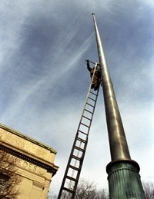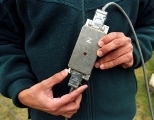On a breezy day, a flag can take a real beating as it blows around at the top of a flagpole. Now there's a way to know just what conditions are like on that pole, thanks to a project that placed sensors at the top of one campus flagpole to transmit data to a web site in real time.
The 102-foot-tall flagpole in Dupont Court outside Building 1 was outfitted with a specially designed system of sensors in February to monitor the motion of the flagpole in the wind. These sensors provide measurements of the response of the structure to the wind, which are combined with measurements of wind conditions and temperature taken by sensors in an environmental monitoring station on top of Building 1. Data from both sets of sensors is continuously transmitted to computers through wireless and wired connections, and placed on the project web site at http://flagpole.mit.edu.
The iCampus Flagpole Instrumentation Project was conceived by Kevin Amaratunga, the Rockwell International Career Development Assistant Professor in the Department of Civil and Environmental Engineering, and his colleagues as an educational experiment combining information technology with the more traditional civil engineering study of structures.
"Students typically experiment in indoor laboratories. The main idea behind this project is to give them a real-world structure to experiment with, by turning the campus into a virtual laboratory," said Amaratunga.
"We started out by proposing that we instrument the Stata Center construction, but there was lots of uncertainty involved with scheduling, so to make it more manageable, we decided to go with something smaller. The flagpole is a very visible structure to students in Building 1. It's also fairly representative of the simple structures that they'd look at in a lab anyway.
"The other idea behind the project was to expose students to new advances in information technology and sensors. It really combines IT with the traditional side of civil engineering," he said.
Two graduate students in civil engineering, Sudarshan Ragunathan and Matthew Echard, handled the majority of the software development and built the sensor boxes, with the help of M.Eng. students, who also built the project web site.
John Coyne, who climbs tall structures for a living, was hired to place a sensor box at the top of the pole, another about a quarter of the way down and a third at the halfway point. He spent about three hours at the top of the flagpole on Feb. 15. Photos on the project web site document his climb, as well as the view from atop the pole.
A data acquisition box buried at the foot of the flagpole collects data from the sensors and transmits it to a computer indoors. From there, the data is broadcast live on the web. The data will be used by students in two undergraduate courses and two graduate courses in the department.
The environmental monitoring station on Building 1 was developed by Professor Louis Bucciarelli in parallel with the flagpole sensing system. The project was funded by iCampus , the MIT-Microsoft Alliance, as part of the iLab initiative led by Professor Jesus del Alamo of electrical engineering and computer science.
A version of this article appeared in MIT Tech Talk on April 3, 2002.







